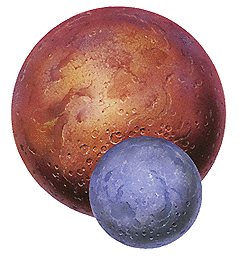Pluto Gets Reclassified Again
No longer a planet, Pluto is now the namesake of its own class of objects: plutoids

Pluto took a big hit in the eyes of schoolchildren and amateur astronomers two years ago when the International Astronomical Union (IAU) knocked it out of the rank of planets. Deemed too small and irregularly shaped, and with its orbit in the path of another planet, Pluto was relegated to a new class of “dwarf planets.” The reclassification came about as the result of discoveries of bodies beyond Pluto’s orbit that are the same size or larger than the icy world. And so Pluto was grouped with those far-out solar-system denizens, along with asteroids close to Pluto’s size. Last week, however, in a nod to Pluto’s past and to the clarification that comes from further narrowing of classification, Pluto once again joined a new rank: the plutoids.
Plutoids are a new class of bodies defined as those which maintain a near-spherical shape and have orbits which may intersect with others beyond the orbit of Neptune. That for now puts Pluto and Eris (a body beyond Pluto at nearly Pluto’s size) as the only objects in the category, but astronomers are certain that many more plutoids will be discovered as telescope technology improves. It does not include asteroids like Ceres, which were previously grouped with Pluto as dwarf planets, because they live within the solar system’s interior. The Kuiper Belt—a belt of asteroids beyond Neptune—is thought to harbor many plutoids.
[Via BBC]